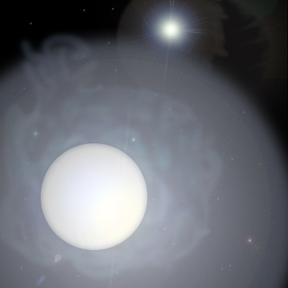RXTE Discoveries
The Return of the Bursting Pulsar (GRO J1744-28) - June 1996
The Bursting Pulsar was discovered in December 1995 by the Burst and Transient Experiment (BATSE) on the Compton Gamma-Ray Observatory. BATSE discovered energetic outbursts of high energy X-rays and low energy gamma rays being emitted every few minutes from this object located near the galactic center. This object, which came to be known as the Bursting Pulsar, brightened to become the brightest X-ray source in the sky in February before steadily fading in April and May. RXTE has observed it extensively since the middle of January. During these months the X-ray bursts occurred approximately once per hour. But the bursts ceased in mid-May. Through its continued monitoring, however, RXTE observed the re-appearance of bursts in early June. The bursts were then seen to last 20-30 seconds, with some bursts lasting as long as 100 seconds.
 |
The video (in avi and QuickTime formats) illustrates our current understanding of this object. Observations show the Bursting Pulsar to consist of a neutron star spinning with a rotation period of 0.467 s. This rotation is indicated in the video by light pulsing from the neutron star about twice a second. In addition, bright outbursts of X-rays and gamma rays (indicated by a bright flash) occur approximately once every hour. Until the bursts temporarily ceased in mid-May, they lasted 2 - 10 seconds, with the X-ray intensity decreasing for a short time after the burst. In addition, the pulsar orbits around another star (seen in the background in the video) with period of 11.8 days. .
|
|
Astronomers do not yet fully understand the Bursting Pulsar. Other objects share some of its properties, but no other object combines these properties so uniquely. Neutron stars which exhibit pulsations are known to undergo a brightening and fading in X-rays over the course of a few months, and some non-pulsing neutron stars have intense X-ray bursts, but the Bursting Pulsar is the only object to do all three. Observations indicate that the pulsar has a strong magnetic field (indicated by dark lines around the neutron star in the latter part of the video). This magnetic field funnels material to the magnetic poles. The subsequent radiation of this material causes the pulses at 0.467 second intervals.
|  |
The cause of the X-ray bursts in the Bursting Pulsar is unknown. In other X-ray bursting sources, the bursts are likely caused by enhanced flow of material onto the neutron star from a surrounding disk. However, none of the known theories for this enhanced flow can operate in the strong magnetic field of the Bursting Pulsar. The dips in X-ray intensity after the X-ray burst may represent some degree of depletion of material from the disk.


